In this scenario 200,000 years ago in Africa a genius member of a random tribe invents a method for making Bronze weapons and tools. This knowledge slowly spreads to other hunter gather tribes in Africa. So that a century later most of the Homo Sapiens in Africa use bronze weapons and tools. What happens when Homo Sapiens begin to spread out from Africa? What other technology will get discovered before the 150,000 year mark?
You are using an out of date browser. It may not display this or other websites correctly.
You should upgrade or use an alternative browser.
You should upgrade or use an alternative browser.
Alternate History Bronze Working Begins in Deep History
- Thread starter Sailor.X
- Start date
More options
Who Replied?In this scenario 200,000 years ago in Africa a genius member of a random tribe invents a method for making Bronze weapons and tools. This knowledge slowly spreads to other hunter gather tribes in Africa. So that a century later most of the Homo Sapiens in Africa use bronze weapons and tools. What happens when Homo Sapiens begin to spread out from Africa? What other technology will get discovered before the 150,000 year mark?
You need mines for that.One for copper,other for zinc.Which mean at least city-states.
In age of hunter-gatheres,not possible.
To be honest,better chances would be with iron made from bog-iron.
Bear Ribs
Well-known member
Bronze requires a really high-end trade network since the component elements don't often appear together (There're exactly three such deposits on the planet, one in Cornwall in the UK, one in Thailand, and one in Iran).
Africa's always suffered from the fact that it has a lousy river network to facilitate internal trade. This means that after whatever lucky break gets somebody the first bronze work, it's soon going to become lost technology unless a trade network can be built, and the ocean's going to be it (It's no coincidence that early bronze was concentrated on the Mediterranean which facilitated trade of the requisite metals). So the main result of this is either going to be a few bronze artifacts that archeologists marvel over when they get uncovered in the modern day, or else Egypt happening some hundred thousand-odd years earlier than the OTL.
Africa's always suffered from the fact that it has a lousy river network to facilitate internal trade. This means that after whatever lucky break gets somebody the first bronze work, it's soon going to become lost technology unless a trade network can be built, and the ocean's going to be it (It's no coincidence that early bronze was concentrated on the Mediterranean which facilitated trade of the requisite metals). So the main result of this is either going to be a few bronze artifacts that archeologists marvel over when they get uncovered in the modern day, or else Egypt happening some hundred thousand-odd years earlier than the OTL.
You need mines for that.One for copper,other for zinc.Which mean at least city-states.
In age of hunter-gatheres,not possible.
To be honest,better chances would be with iron made from bog-iron.
Points to Alien Space Bats. Now that you know who is giving them stuff roll with the scenario.Bronze requires a really high-end trade network since the component elements don't often appear together (There're exactly three such deposits on the planet, one in Cornwall in the UK, one in Thailand, and one in Iran).
Africa's always suffered from the fact that it has a lousy river network to facilitate internal trade. This means that after whatever lucky break gets somebody the first bronze work, it's soon going to become lost technology unless a trade network can be built, and the ocean's going to be it (It's no coincidence that early bronze was concentrated on the Mediterranean which facilitated trade of the requisite metals). So the main result of this is either going to be a few bronze artifacts that archeologists marvel over when they get uncovered in the modern day, or else Egypt happening some hundred thousand-odd years earlier than the OTL.
Points to Alien Space Bats. Now that you know who is giving them stuff roll with the scenario.
Well,that explain everything.
P.S i remember some short sci-fi novel/forget author and name,as usual/
Where aliens come to Earth with goal of uplifting us.Problem is - humans want to remain hunter-gatherers.
So,when visitation come,local alien builded city,bribed locals with pretending to be cyvilized,show it to his superior - who said ha,ha,i saw through you,but you are lucky - uplifting Earth is abadonned,so we could come back.
And that is how Atlantis come to reality - becouse city remained.
Sounds like the Humans in that novel were idiots.Well,that explain everything.
P.S i remember some short sci-fi novel/forget author and name,as usual/
Where aliens come to Earth with goal of uplifting us.Problem is - humans want to remain hunter-gatherers.
So,when visitation come,local alien builded city,bribed locals with pretending to be cyvilized,show it to his superior - who said ha,ha,i saw through you,but you are lucky - uplifting Earth is abadonned,so we could come back.
And that is how Atlantis come to reality - becouse city remained.
Bear Ribs
Well-known member
Eh... handwavey. The Hunter/Gatherer stage was one of the peaks of human civilization. They basically worked maybe fifteen hours a week (estimates vary between 8 and 20 hours a week, depending on the terrain). That level of civilization can't actually support dense numbers of humans but before you hit that limit cap, it's a crazy easy life filled with fun. I can easily see such a group looking at agriculture and it's 30 hour workweek and going @&% no!Sounds like the Humans in that novel were idiots.
And then agricultural societies seeing our modern 45-50 hour workweeks where our play is pretending to be hunter-gatherers and scratching their heads trying to figure out where the progress is...
Yeah about thatEh... handwavey. The Hunter/Gatherer stage was one of the peaks of human civilization. They basically worked maybe fifteen hours a week (estimates vary between 8 and 20 hours a week, depending on the terrain). That level of civilization can't actually support dense numbers of humans but before you hit that limit cap, it's a crazy easy life filled with fun. I can easily see such a group looking at agriculture and it's 30 hour workweek and going @&% no!
And then agricultural societies seeing our modern 45-50 hour workweeks where our play is pretending to be hunter-gatherers and scratching their heads trying to figure out where the progress is...
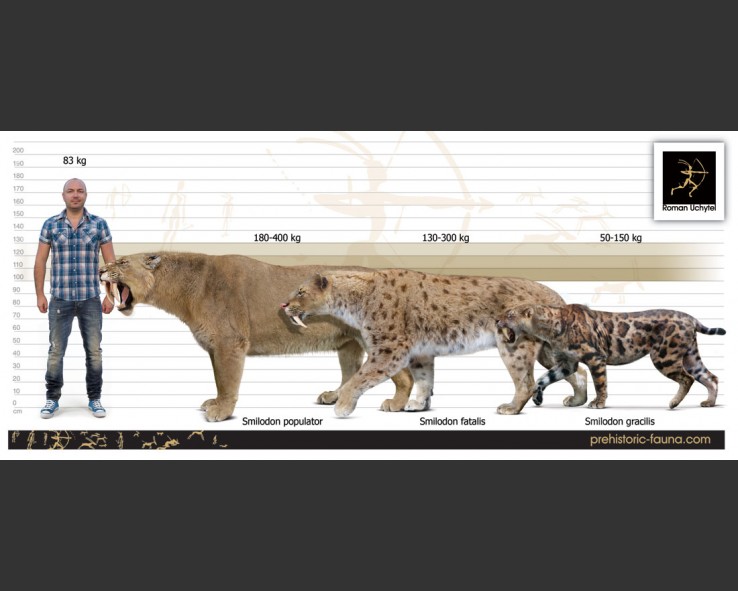

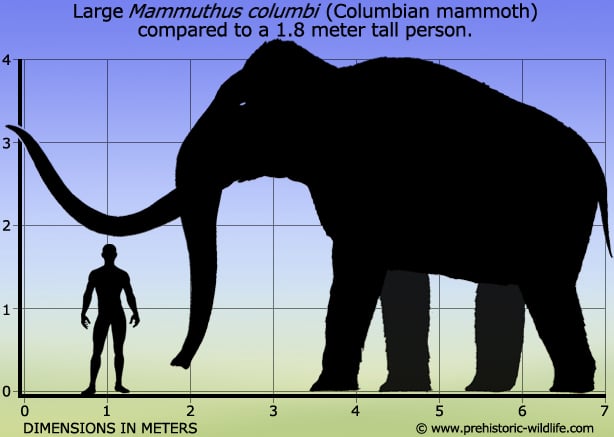
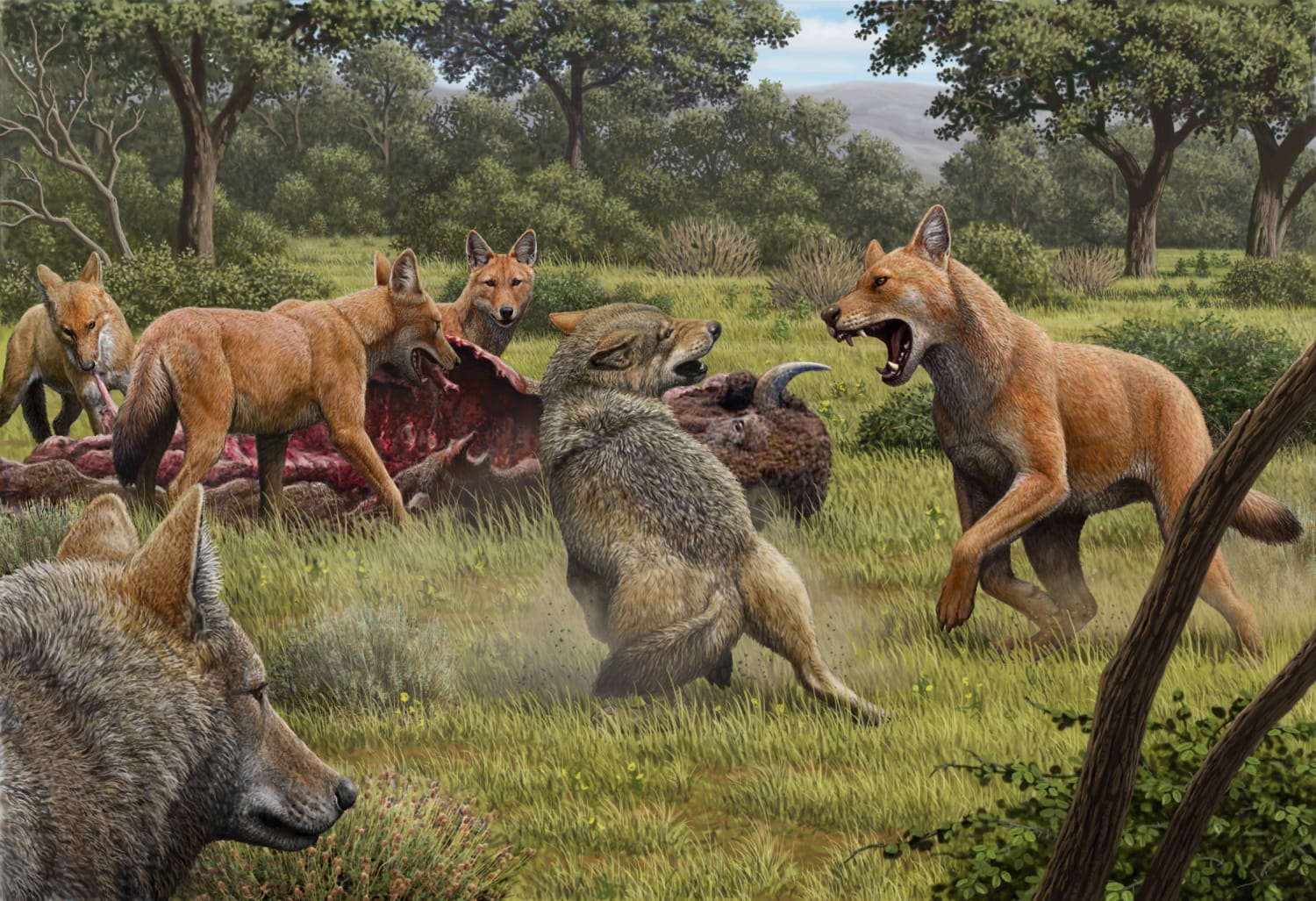
Let's just say my ancestors would have jumped at the chance for and Uplift. Pleistocene North America was a Death World. Being a Hunter Gatherer here sucked. So much so that ancient stories from those times still exist talking about how much it sucked.
Bear Ribs
Well-known member
And yet we can find massive graveyards of those animals where hunter-gatherers casually killed them in job-lots. Note that one of the leading theories as to what caused the Quarternary Extinction is that we ate them all. We've got multiple records of entire mammoth herds driven into a canyon where they all died of fall damage, followed by being eaten. Hunter-Gatherers may have only worked fifteen hours a week but those fifteen hours were pretty murderous. Smilodon Fatalis got nothin' on a hungry hunter-gatherer who's ticked he's going to have to work a whole sixteenth hour this week.Yeah about that






Let's just say my ancestors would have jumped at the chance for and Uplift. Pleistocene North America was a Death World. Being a Hunter Gatherer here sucked. So much so that ancient stories from those times still exist talking about how much it sucked.
Maybe easy in Eurasia but North America was a far more deadly place. The same with Africa. Eurasia did not get some of the deadly beasts that were here in NA.And yet we can find massive graveyards of those animals where hunter-gatherers casually killed them in job-lots. Note that one of the leading theories as to what caused the Quarternary Extinction is that we ate them all. We've got multiple records of entire mammoth herds driven into a canyon where they all died of fall damage, followed by being eaten. Hunter-Gatherers may have only worked fifteen hours a week but those fifteen hours were pretty murderous.
For instance Europeans did not have to deal with 25ft Long Alligators and Crocodiles. My Ancestors did.
Edit: And Prehistoric Man did not hunt all the Megafauna into extinction. One we did not exist in the numbers to do so. Remember Toba happened. Human populations survived the Toba volcanic super-eruption 74,000 years ago -- ScienceDaily
And this happened right as the bulk of the Mega Fauna disappeared.
Evidence for an extraterrestrial impact 12,900 years ago that contributed to the megafaunal extinctions and the Younger Dryas cooling | PNAS
Last edited:
Maybe easy in Eurasia but North America was a far more deadly place. The same with Africa. Eurasia did not get some of the deadly beasts that were here in NA.
For instance Europeans did not have to deal with 25ft Long Alligators and Crocodiles. My Ancestors did.
Edit: And Prehistoric Man did not hunt all the Megafauna into extinction. One we did not exist in the numbers to do so. Remember Toba happened. Human populations survived the Toba volcanic super-eruption 74,000 years ago -- ScienceDaily
And this happened right as the bulk of the Mega Fauna disappeared.
Evidence for an extraterrestrial impact 12,900 years ago that contributed to the megafaunal extinctions and the Younger Dryas cooling | PNAS
Your ancestors also faced giant birds.Some claim,that they hunt children to our times!
Back to topic - what do you think about early humans making iron from bog-iron?
P.S still,they need to work less then settled people.And,were more healthy.
Bear Ribs
Well-known member
Actually I was talking about North America specifically when I mentioned those graveyards. Not that Eurasia was any better, it had its fair share of megafauna, but spikier than North America. Including giant crocodilians that lasted until the late miocene/early pliocene.Maybe easy in Eurasia but North America was a far more deadly place. The same with Africa. Eurasia did not get some of the deadly beasts that were here in NA.
For instance Europeans did not have to deal with 25ft Long Alligators and Crocodiles. My Ancestors did.
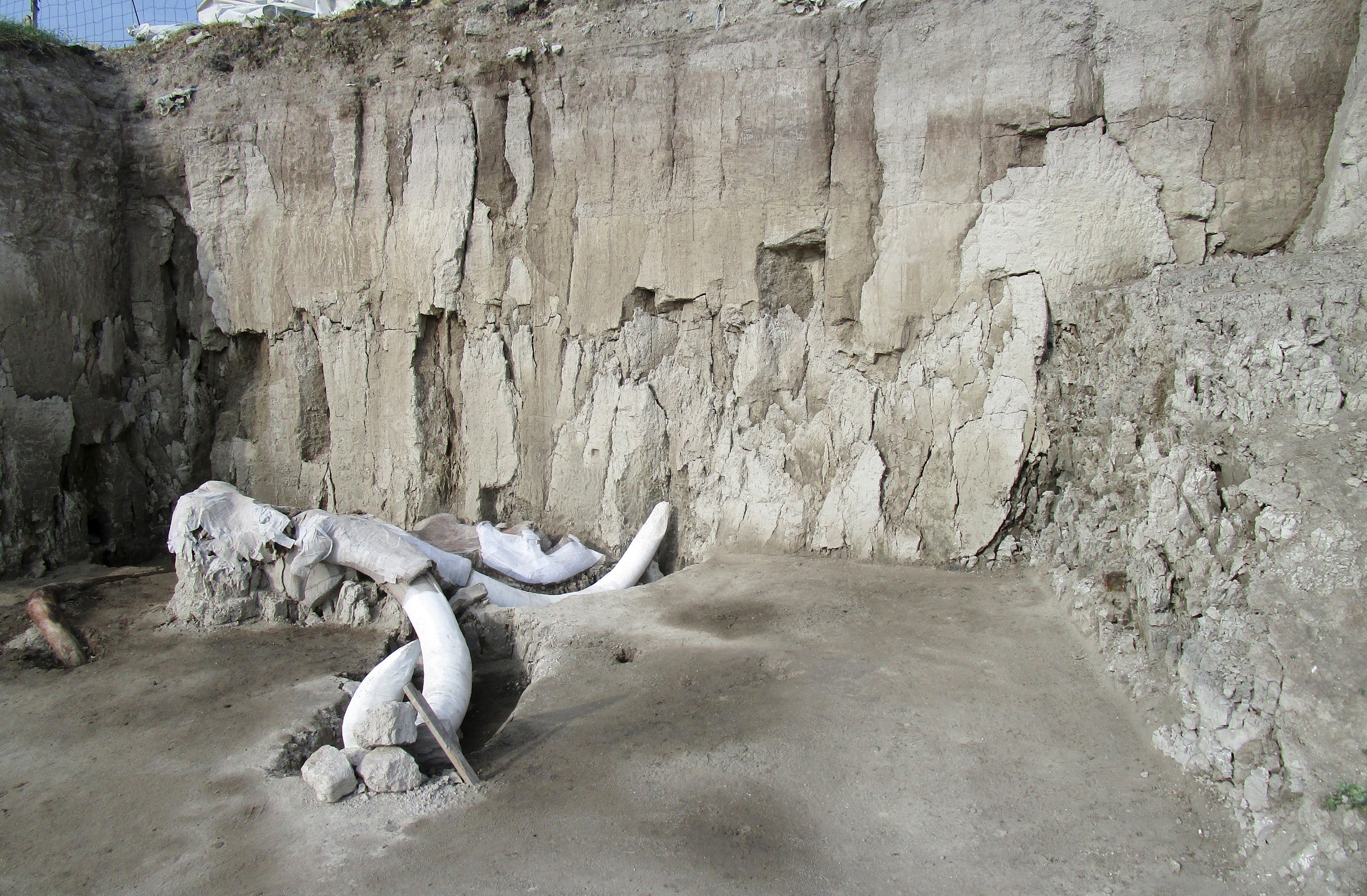
'Mammoth traps' built by prehistoric hunters discovered in Mexico
15,000-year-old mammoth traps built by prehistoric humans have been discovered in Mexico.
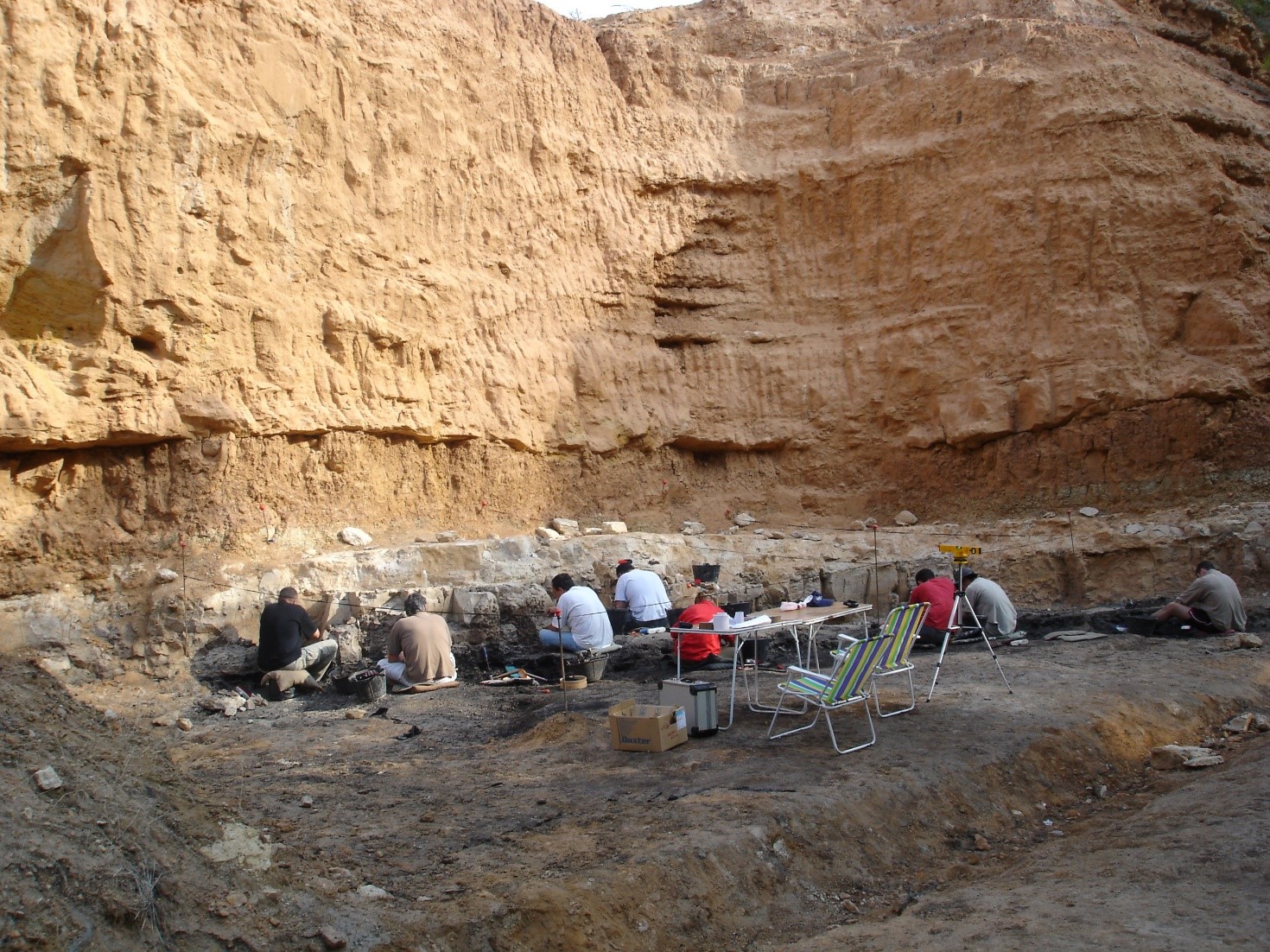
The mystery of the crocodiles that appeared in Europe at the end of the Miocene « Earth & Environmental Science# « Cambridge Core Blog
There are no crocodilians in Europe, which is good for the safety of those of us who like to peacefully fish or swim in lakes and rivers, but it is somewhat sad for those who prize biodiversity or simply like these fascinating predators.

I hate to tell you, but 74,000 years ago isn't actually the same as 12,900 years ago. There are enough years in between for a human tribe to get busy. Especially since they were only working fifteen hours a week and so had more time for nookie than a modern Japanese Sarariman. That is, after all, the period of time where humanity expanded from "Only one village survived" to "Human tribes on every continent except Antarctica." 'Course they had to eat a lot in order to multiply so much...Edit: And Prehistoric Man did not hunt all the Megafauna into extinction. One we did not exist in the numbers to do so. Remember Toba happened. Human populations survived the Toba volcanic super-eruption 74,000 years ago -- ScienceDaily
And this happened right as the bulk of the Mega Fauna disappeared.
Evidence for an extraterrestrial impact 12,900 years ago that contributed to the megafaunal extinctions and the Younger Dryas cooling | PNAS
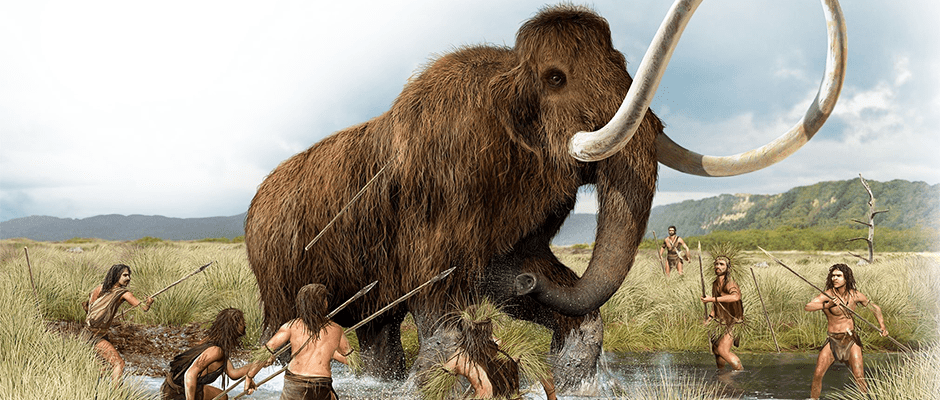
Early humans also drove megafaunal extinctions - The Wildlife Society
When humans reached North America 13,000 years ago, 78 species that weighed over a ton vanished in the terminal Pleistocene megafauna extinction. After scrutinizing the fossil record, a team of...
 wildlife.org
wildlife.org
Skallagrim
Well-known member
I agree with your overall points, but I have to disagree with the specific point about humans causing those mass extinctions. The article you link is extremely self-serving in pushing a desired narrative, and conspicuously silent about alternative -- quite possibly superior -- explanations for the observed data.hate to tell you, but 74,000 years ago isn't actually the same as 12,900 years ago. There are enough years in between for a human tribe to get busy. Especially since they were only working fifteen hours a week and so had more time for nookie than a modern Japanese Sarariman. That is, after all, the period of time where humanity expanded from "Only one village survived" to "Human tribes on every continent except Antarctica." 'Course they had to eat a lot in order to multiply so much...

Early humans also drove megafaunal extinctions - The Wildlife Society
When humans reached North America 13,000 years ago, 78 species that weighed over a ton vanished in the terminal Pleistocene megafauna extinction. After scrutinizing the fossil record, a team of...wildlife.org
The reasoning followed is that humans moved out of Africa, and then megafauna went bye-bye, and therefore it wuz da humies wot dunnit.
This rather ignores that the time-table doesn't add up. Humans moved out of Africa way, way, waaaaaayyyyyy before the megafauna started to really decline. And in fact, the human sub-species that (descended from those that) moved out first (most notably the Neanderthals) were using very inefficient "kill lots of 'em, eat what we can leave the rest to rot" methods. Homo Sapiens in fact represented a trend of greater efficiency ("kill what we can eat now").
Naturally, the expansion of homo sapiens does represent a period of population growth. But that was also limited until the Ice Age really ended. And then things got wild. It has been argued (in my opinion, convincingly) that the megafauna was well-suited to the Ice Age, but had trouble adapting to the changing conditions. The population boom of homo sapiens certainly didn't help, but in what I consider to be the most convincing reading of the data, humans merely "finished the job" that the climate had already done for the most part.
As for North America in particular: I find the idea of a Younger Dryas impact event to be at the very least plausible, and as more evidence is uncovered, I find myself leaning ever more towards this hypothesis. The impact event would have centred on North America, causing pretty terrible conditions in great regions. In a turn of (pre-)historic irony, the climate conditions in North America had been relatively stable. The effect was that up until that point, megafauna in North America did better than in much of Eurasia.
The "humans did it" hypothesis, naturally, points towards the fact that humans arrived late in the Americas, and that's why the megafauna lasted longer. I don't find that convincing. The megafauna extinction in America started over 10.000 years after humans arrived on the scene, and then happened quite suddenly. With a bang, one might say.
The idea that humans hunted the megafauna to extinctions becomes shaky when we note that the megafauna extinctions -- everywhere -- occurred between 10.000 and 30.000 years after homo sapiens showed up; that they happened precisely during a great climate shift; that they occurred earlier where climate shifted earlier, and later where the climate shifts were less severe; and that in a place where a megafauna population did fairly well until relatively recently (North America) this suddenly and dramatically shifted precisely in the period when something caused a sudden and dramatic thousand-year climate swing that we call the Younger Dryas.
Based on these considerations (which, I admit, I have presented here crudely and hastily) I really think that the megafauna extinctions were chiefly caused by external factors (global climate shifts and quite plausibly a serious impact event), and not by human action. At most, humans played a relatively minor role in the process. More that of a vulture than of a great and ravenous predator, really.
(And in the article you linked, a clue to the true motivations between the "humans did it" hypothesis is found quight away, when the author blames humanity for it all, and then goes on to add "...much as human activity today is leading to extinctions". This accusation, thrown at the feet of humanity, is politically motivated.)
The Human hunting Megafauna to extinction has fallen out of favor for some good reasons. 1 the most common Megafauna in North America were not Mammoths or even Bison. It was Camels and Horses. And no mass kill sites have been found for them. None. 2 mounting evidence of an asteroid strike in the late Pleistocene. 3 Human population size in North America during that time was rally small. 4 before the Asteroid strike you can find Clovis points. Literally just after it you find none. Same with all large animals. The Bison we have today ate not the same Bison during Pleistocene NA. They migrated in after the strike.Actually I was talking about North America specifically when I mentioned those graveyards. Not that Eurasia was any better, it had its fair share of megafauna, but spikier than North America. Including giant crocodilians that lasted until the late miocene/early pliocene.

'Mammoth traps' built by prehistoric hunters discovered in Mexico
15,000-year-old mammoth traps built by prehistoric humans have been discovered in Mexico.www.foxnews.com

The mystery of the crocodiles that appeared in Europe at the end of the Miocene « Earth & Environmental Science# « Cambridge Core Blog
There are no crocodilians in Europe, which is good for the safety of those of us who like to peacefully fish or swim in lakes and rivers, but it is somewhat sad for those who prize biodiversity or simply like these fascinating predators.www.cambridge.org

I hate to tell you, but 74,000 years ago isn't actually the same as 12,900 years ago. There are enough years in between for a human tribe to get busy. Especially since they were only working fifteen hours a week and so had more time for nookie than a modern Japanese Sarariman. That is, after all, the period of time where humanity expanded from "Only one village survived" to "Human tribes on every continent except Antarctica." 'Course they had to eat a lot in order to multiply so much...

Early humans also drove megafaunal extinctions - The Wildlife Society
When humans reached North America 13,000 years ago, 78 species that weighed over a ton vanished in the terminal Pleistocene megafauna extinction. After scrutinizing the fossil record, a team of...wildlife.org
Bear Ribs
Well-known member
The issue with the impact hypothesis is that the megafauna dieoffs didn't happen at the same time on each continent, which would be the case if a single massive event was responsible. "Humans arrived to the Americas later, and America's megafauna vanished later" is something that should rightly be considered incredibly convincing.I agree with your overall points, but I have to disagree with the specific point about humans causing those mass extinctions. The article you link is extremely self-serving in pushing a desired narrative, and conspicuously silent about alternative -- quite possibly superior -- explanations for the observed data.
The reasoning followed is that humans moved out of Africa, and then megafauna went bye-bye, and therefore it wuz da humies wot dunnit.
This rather ignores that the time-table doesn't add up. Humans moved out of Africa way, way, waaaaaayyyyyy before the megafauna started to really decline. And in fact, the human sub-species that (descended from those that) moved out first (most notably the Neanderthals) were using very inefficient "kill lots of 'em, eat what we can leave the rest to rot" methods. Homo Sapiens in fact represented a trend of greater efficiency ("kill what we can eat now").
Naturally, the expansion of homo sapiens does represent a period of population growth. But that was also limited until the Ice Age really ended. And then things got wild. It has been argued (in my opinion, convincingly) that the megafauna was well-suited to the Ice Age, but had trouble adapting to the changing conditions. The population boom of homo sapiens certainly didn't help, but in what I consider to be the most convincing reading of the data, humans merely "finished the job" that the climate had already done for the most part.
As for North America in particular: I find the idea of a Younger Dryas impact event to be at the very least plausible, and as more evidence is uncovered, I find myself leaning ever more towards this hypothesis. The impact event would have centred on North America, causing pretty terrible conditions in great regions. In a turn of (pre-)historic irony, the climate conditions in North America had been relatively stable. The effect was that up until that point, megafauna in North America did better than in much of Eurasia.
The "humans did it" hypothesis, naturally, points towards the fact that humans arrived late in the Americas, and that's why the megafauna lasted longer. I don't find that convincing. The megafauna extinction in America started over 10.000 years after humans arrived on the scene, and then happened quite suddenly. With a bang, one might say.
The idea that humans hunted the megafauna to extinctions becomes shaky when we note that the megafauna extinctions -- everywhere -- occurred between 10.000 and 30.000 years after homo sapiens showed up; that they happened precisely during a great climate shift; that they occurred earlier where climate shifted earlier, and later where the climate shifts were less severe; and that in a place where a megafauna population did fairly well until relatively recently (North America) this suddenly and dramatically shifted precisely in the period when something caused a sudden and dramatic thousand-year climate swing that we call the Younger Dryas.
Based on these considerations (which, I admit, I have presented here crudely and hastily) I really think that the megafauna extinctions were chiefly caused by external factors (global climate shifts and quite plausibly a serious impact event), and not by human action. At most, humans played a relatively minor role in the process. More that of a vulture than of a great and ravenous predator, really.
(And in the article you linked, a clue to the true motivations between the "humans did it" hypothesis is found quight away, when the author blames humanity for it all, and then goes on to add "...much as human activity today is leading to extinctions". This accusation, thrown at the feet of humanity, is politically motivated.)
As for "Humans arrived thousands of years earlier" that's quite true, but ignores that humans would have needed centuries to build up their numbers to proper extinction-event levels. Additionally, we have a clear chain of evidence showing why the extinction happened when it did: Technology.
The Fishtail Point Projectile, "Clovis Point" was vastly more advanced and more effective than any previous point. It spread rapidly, and as charted, where it appear the Megafauna almost instantly vanished.
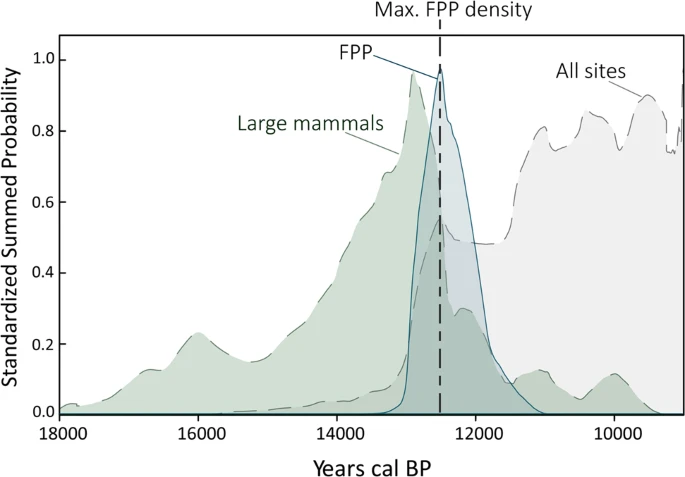
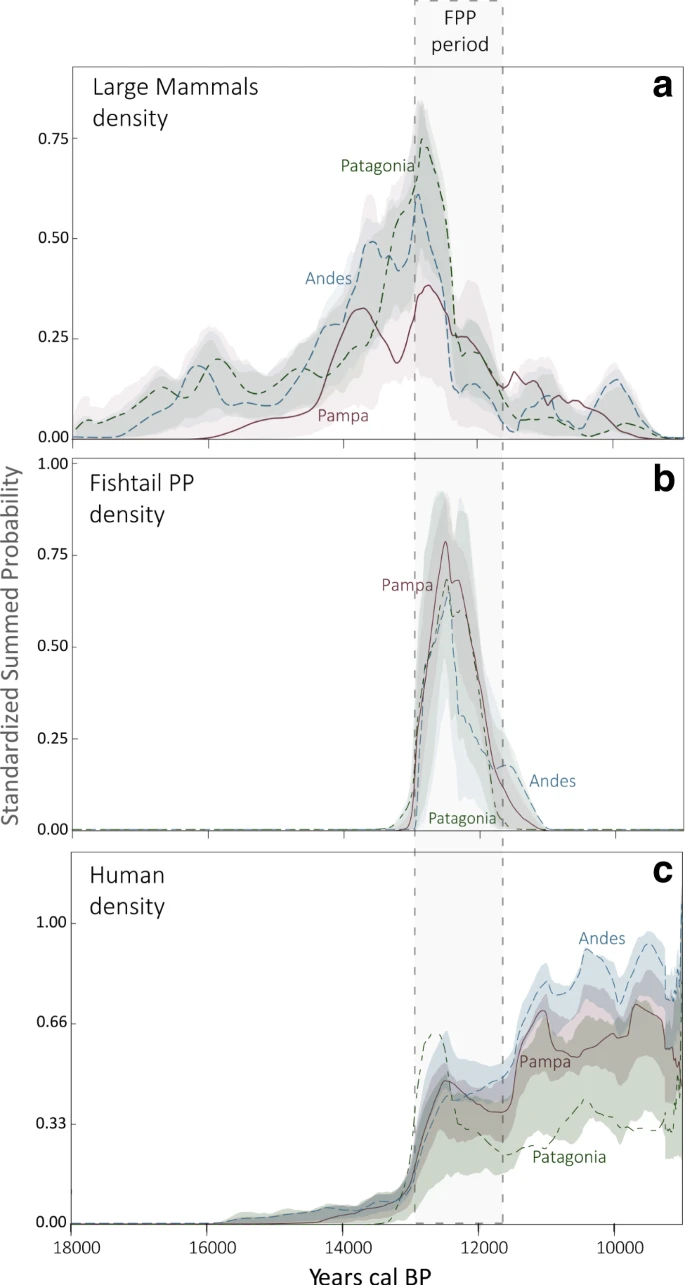
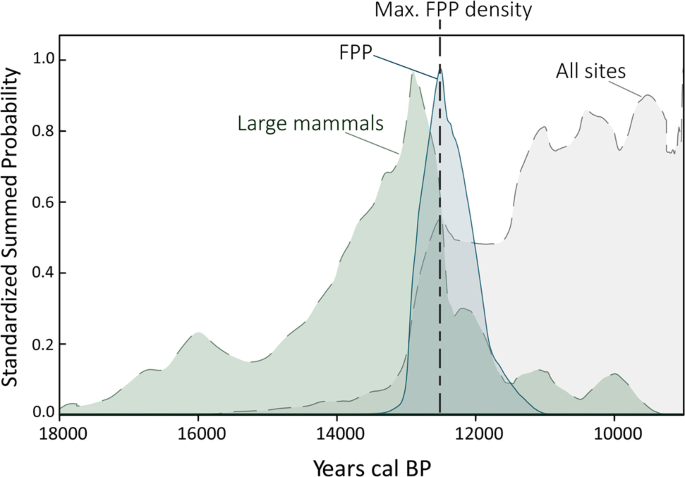
Late Pleistocene South American megafaunal extinctions associated with rise of Fishtail points and human population - Nature Communications
Human arrival in South America predated the extinction of regional megafauna by a substantial margin, which has suggested a different cause for the extinctions. However, here, the authors show that megafaunal extinctions do correspond to the spread of hunting tools and human population shifts.
Actually we do have camel and horse hunting sites.The Human hunting Megafauna to extinction has fallen out of favor for some good reasons. 1 the most common Megafauna in North America were not Mammoths or even Bison. It was Camels and Horses. And no mass kill sites have been found for them. None. 2 mounting evidence of an asteroid strike in the late Pleistocene. 3 Human population size in North America during that time was rally small. 4 before the Asteroid strike you can find Clovis points. Literally just after it you find none. Same with all large animals. The Bison we have today ate not the same Bison during Pleistocene NA. They migrated in after the strike.
LATE PLEISTOCENE WESTERN CAMEL (CAMELOPS HESTERNUS) HUNTING IN SOUTHWESTERN CANADA on JSTOR
Brian Kooyman, L.V. Hills, Shayne Tolman, Paul McNeil, LATE PLEISTOCENE WESTERN CAMEL (CAMELOPS HESTERNUS) HUNTING IN SOUTHWESTERN CANADA, American Antiquity, Vol. 77, No. 1 (January 2012), pp. 115-124
The Impact Hypothesis is the one that's fallen out of favor and is generally considered a fringe position. When "blind" studies were done to look for proof of an impact, they didn't find anything in 9 different sites. If there was an impact, it would appear to be far too localized to have produced a mass die off, or to leave evidence outside of a small local area. This was verified in another study that analyzed nanodiamond evidence, and found that proof of any impact was extremely localized.

A Blind Test of the Younger Dryas Impact Hypothesis
The Younger Dryas Impact Hypothesis (YDIH) states that North America was devastated by some sort of extraterrestrial event ~12,800 calendar years before present. Two fundamental questions persist in the debate over the YDIH: Can the results of analyses ...
Comprehensive analysis of nanodiamond evidence reported to support the Younger Dryas Impact Hypothesis
Sorry champ but. New evidence that an extraterrestrial collision 12,800 years ago triggered an abrupt climate change for EarthThe issue with the impact hypothesis is that the megafauna dieoffs didn't happen at the same time on each continent, which would be the case if a single massive event was responsible. "Humans arrived to the Americas later, and America's megafauna vanished later" is something that should rightly be considered incredibly convincing.
As for "Humans arrived thousands of years earlier" that's quite true, but ignores that humans would have needed centuries to build up their numbers to proper extinction-event levels. Additionally, we have a clear chain of evidence showing why the extinction happened when it did: Technology.
The Fishtail Point Projectile, "Clovis Point" was vastly more advanced and more effective than any previous point. It spread rapidly, and as charted, where it appear the Megafauna almost instantly vanished.


Actually we do have camel and horse hunting sites.
Late Pleistocene South American megafaunal extinctions associated with rise of Fishtail points and human population - Nature Communications
Human arrival in South America predated the extinction of regional megafauna by a substantial margin, which has suggested a different cause for the extinctions. However, here, the authors show that megafaunal extinctions do correspond to the spread of hunting tools and human population shifts.www.nature.com
LATE PLEISTOCENE WESTERN CAMEL (CAMELOPS HESTERNUS) HUNTING IN SOUTHWESTERN CANADA on JSTOR
Brian Kooyman, L.V. Hills, Shayne Tolman, Paul McNeil, LATE PLEISTOCENE WESTERN CAMEL (CAMELOPS HESTERNUS) HUNTING IN SOUTHWESTERN CANADA, American Antiquity, Vol. 77, No. 1 (January 2012), pp. 115-124www.jstor.org
The Impact Hypothesis is the one that's fallen out of favor and is generally considered a fringe position. When "blind" studies were done to look for proof of an impact, they didn't find anything in 9 different sites. If there was an impact, it would appear to be far too localized to have produced a mass die off, or to leave evidence outside of a small local area. This was verified in another study that analyzed nanodiamond evidence, and found that proof of any impact was extremely localized.

A Blind Test of the Younger Dryas Impact Hypothesis
The Younger Dryas Impact Hypothesis (YDIH) states that North America was devastated by some sort of extraterrestrial event ~12,800 calendar years before present. Two fundamental questions persist in the debate over the YDIH: Can the results of analyses ...www.ncbi.nlm.nih.gov

Comprehensive analysis of nanodiamond evidence reported to support the Younger Dryas Impact Hypothesis
researchportal.port.ac.uk
And to add.
Humans were in North America thousands of years before the so called us killing them out.
/https%3A%2F%2Ftf-cmsv2-smithsonianmag-media.s3.amazonaws.com%2Ffiler_public%2Fb1%2F64%2Fb1648d7b-eecf-4eb5-a0dc-4ed890643f25%2Ffootprints.jpg)
Prehistoric Footprints Push Back Timeline of Humans' Arrival in North America
Found in New Mexico, the fossilized impressions date to between 21,000 and 23,000 years ago, a new study suggests
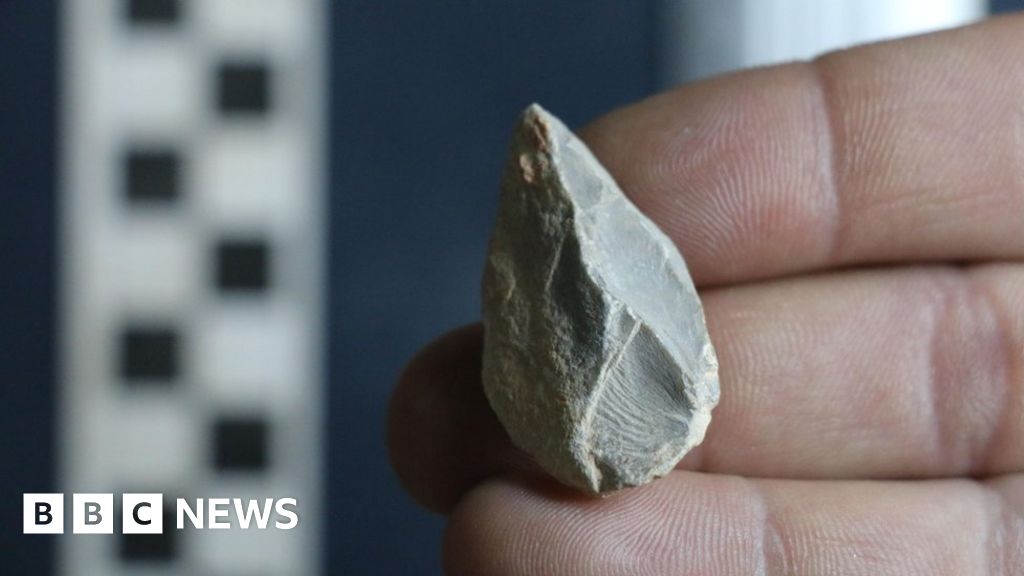
Earliest evidence for humans in the Americas
Humans settled in the Americas much earlier than previously thought, according to new finds from Mexico.
And to add Humans have been living in Africa the longest and Africa still has a shit ton of Hunter Gatherers after 12,000 years ago along with Megafauna. So the over hunting theory is still bunk.
Yup! It was also a major part of the cultures/civilizations in the time-period of the Bronze Age Collapse; fascinating period of history.Bronze requires a really high-end trade network since the component elements don't often appear together (There are exactly three such deposits on the planet, one in Cornwall in the UK, one in Thailand, and one in Iran).
[...]
They had their own mini-Silk Road going on, with trade as far off as Cornwall for copper. Each empire warred with one another, but they also relied on one another, too (so their 'wars' were actually minor things over territory and the like, like duels with small armies).
And then the Collapse happened; then the invasions of the Sea Peoples, which changed their little bubble of duel/ceremonial-warfare to actual warfare with the introduction of iron weapons from the various invaders.
Users who are viewing this thread
Total: 2 (members: 0, guests: 2)
